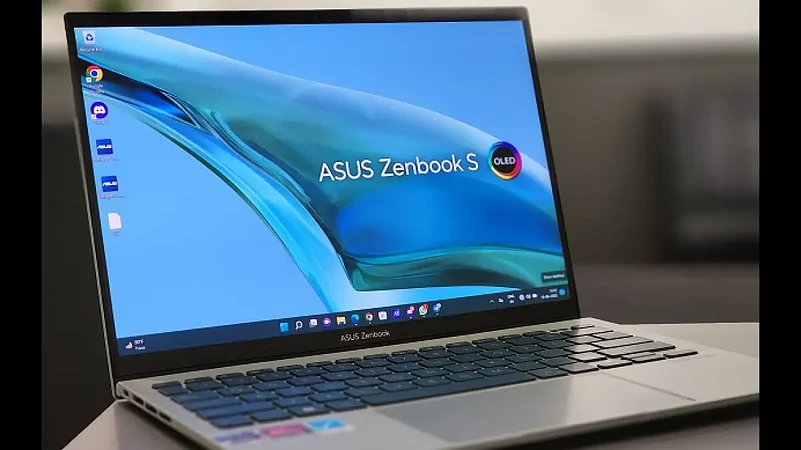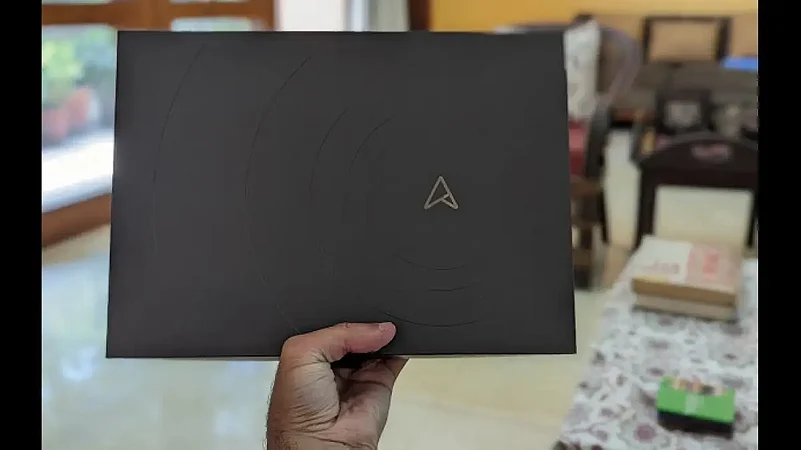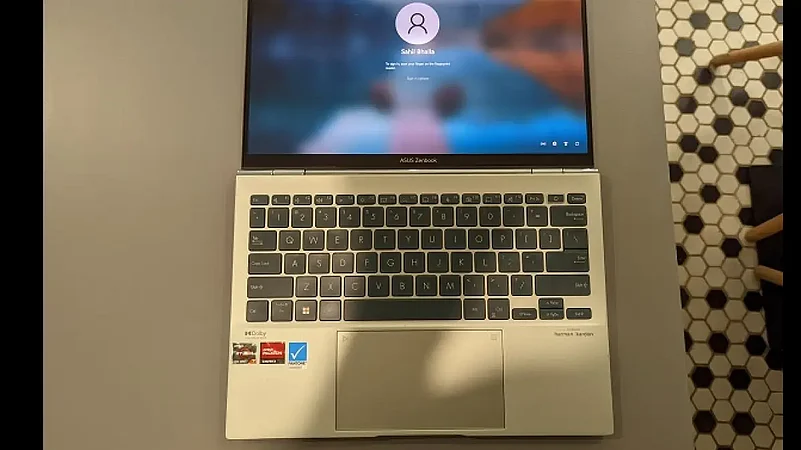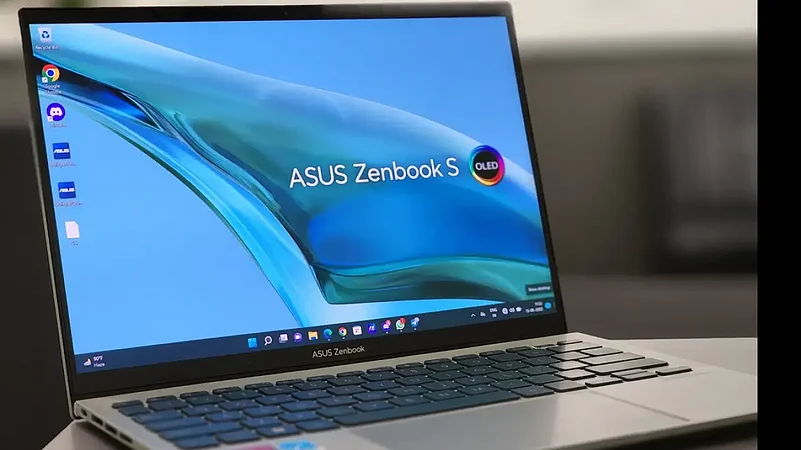As I sit down in a cafe, order my cup of coffee, and take out the Asus Zenbook S 13 OLED I have for review, I can’t help but feel extremely happy but also very frustrated.
I’m a happy camper because I know that the Zenbook S 13 OLED can easily last me a full day of work even as I sit in a cafe where all the plug points are already taken. My mixed-work usage consists of editing documents, some light photo editing, watching YouTube videos and even racing in a few rounds of DIRT 5. With this usage pattern, I comfortably got over 6 hours from the 67 watt-hours worth of battery that Asus crammed into this extremely thin and light ultrabook. Without any gaming, it’d last me even longer on a single charge.
Advertisement

But, as I said above, I’m also frustrated. This is because the Zenbook S 13 OLED is short on ports. I brought along my MX Master 3 from Logitech (one of the best wireless mice out there) but forgot to bring along a dongle. I sat in the cafe, having to use the touchpad, instead of the comfortable mice I had with me.
Laptops are able to get thinner and lighter thanks to the increased efficiency from the newest chips on the block. The Zenbook S 13 OLED from Asus is a thin-and-light ultrabook that is attractive, has a good build and is one of the first to incorporate the Ryzen 7 6800U from AMD.
Advertisement
The new Ryzen chip allows for the laptop to be extremely thin and is also the major reason why the battery life is tremendously good. To manufacture a laptop this thin and light, Asus had to make some sacrifices along the way. Chief amongst them is the port selection. Yes, the Zenbook S 13 OLED is light on ports.

There may be three USB Type-C ports (two on the right, and one on the left) and even a 3.5mm headphone jack (on the right side) but there isn’t any USB-A port. That’s a shame. Those who need to plug in external mice, need an SD card reader or even connect the laptop to an HDMI cable will have to always remember to carry along some dongles. To alleviate this, Asus has included a USB-C to USB-A adapter in the box. Still, my muscle memory isn’t yet ready to remember to carry a dongle around at all times.
Asus may have chosen that heat dissipation matters more to such a laptop than a USB-A port. Some consumers may disagree, but it’s something they’ll have to live with if they go out and buy the Zenbook S 13 OLED.
With a high-resolution OLED display and extremely good battery life, the S 13 OLED is one of the best ultrabooks in the market right now. Let me get into more details and tell you why.
Here’s what you get with the Zenbook S 13 OLED ultrabook
- CPU: AMD Ryzen 7 6800U
- Graphics: AMD Radeon 680M (integreated)
- Storage: 1TB SSD
- Memory: 16GB LPDDR5 RAM
- Display: 13.3-inch OLED (2880x1800 resolution) with 16:10 aspect ratio
- Camera: 720p
- Battery: 67 WHr
- Power adapter: 65W
- Weight: 1.1 kg
- Price: Starting price ₹99,990. Price of the variant I have for review: ₹1,19,990.
Advertisement
A bolt of lightning
The brand-new and minimal Asus monogram logo is love at first sight from the moment you unbox the Zenbook S 13 OLED. The Zenbook S 13 OLED is one of the first notebooks from Asus to sport the new stylized Asus logo. Maybe I like it more because it seems heavily inspired by the Star Trek icon. It is a breath of fresh air. There’s nothing else on the lid except a small “Asus Zenbook” wordmark at the bottom.

The Zenbook S 13 OLED is a little laptop with a big heart. The laptop may look like it is pure aluminium but instead, it is magnesium aluminium alloy. It may have a plastic feeling to it but the build quality is, for the most part, quite solid. It’s a minimalist design that will go down well with a lot of consumers. The only annoying/negative mark that I’ll give Asus is the fact that there are numerous stickers on the palm rest. Nobody needs dozens of stickers. You’re purchasing a laptop not a book about the laptop.
Advertisement
The thing that caught my attention immediately was the ‘zen-capped 180* hinge’. It’s a gorgeous hinge. The hinge is attached to a circular bar alongside the back of the gadgets. It isn’t a mechanical part but it sure does look and feel like one. It’s been designed with premium caps and spans the entire length of the laptop. The best part is that this allows the display to be tilted all the way back to 180*. Furthermore, with the ErgoLift, the keyboard is slightly raised, which helps allow for a better typing experience and also improved airflow.
The one downside that was immediately noticeable was that the power button (that doubles up as a fingerprint reader) has been swapped with the delete key vis-a-vis the previous notebooks from Asus. The company claims that this was due to strong customer feedback, but I’m not buying it. The delete key is now further to reach and it is something that most consumers will use much more frequently than the power button.
Advertisement

Last, but not least, the OLED display is an absolute delight. It’s a 2.8K (2880x1800 resolution) touchscreen display, along with a 16:10 aspect ratio and slim bezels. It’s got one of the best displays in the segment. Watching movies from the likes of Anurag Kashyap or playing DIRT 5 is a truly wonderful experience. The display comes with good dynamic range. With a peak brightness of 500 nits, the laptop can be used outdoors, without any problems. I would have liked a 90Hz or even a 120Hz panel, but the Samsung-made OLED pane is capped at 60Hz on the Zenbook S 13 OLED. It’s not a dealbreaker, but it is certainly noticeable, especially after you’ve been exposed to higher refresh displays.
Advertisement
Lightning-fast performance
No, the Zenbook S 13 OLED isn’t a gaming laptop. Thanks to the improved integrated graphics from Asus, the Zenbook S 13 OLED can handle casual games with aplomb. The Zenbook S13 OLED is more for creative professionals than anyone else and it delivers with some seriously good performance.
The two games I tried were Fortnite and DIRT 5. With Fortnite, I had to turn down the graphics to high and with that I was able to get about 33 frames per second (fps).
Push it a little bit though and it does get toasty. After a few hours of intensive typing on Google Docs, playing music on Spotify and having my stock market applications open, the keys did feel warmer than usual. It was, however, never too uncomfortable to use.
With the Zenbook S 13 OLED you get to tune the performance with Whsiper, Balanced and Performance modes. Unless you’re a stickler for noise, the performance mode will do you just fine. Using the performance mode, and pushing the laptop with some photo editing and casual gaming, and I could barely hear the fans in the cafe where I’m writing this review.
For day-to-day activities, the Zenbook S 13 OLED absolutely flies. There’s almost no stutter or lag when opening and closing applications and even having a 100 Google Chrome tabs open at once will not slow the laptop down.
There are two speakers located under the front of the chassis. They’re driven by a smart amplifier. At 75% volume, I got clear mids and highs. There’s no extra bass here but these speakers are good enough to stream YouTube, Amazon Prime or whatever videos you want without having to connect to an external speaker.
The touchpad, as with most Asus laptops, has the Asus NumberPad 2.0. This means that the touchpad can turn into an LED numeric keypad, especially useful for those that deal with numbers on a daily basis.
The one big improvement was with respect to the webcam. It’s now a FUll HD model and incorporates 3D noise-reduction technology. In the few video calls I took from the laptop, this provided an excellent image and sound quality.
Is the Zenbook S 13 OLED worthy of your hard earned money?
The answer is a loud and resounding yes. I haven’t tested the new Dell XPS 13 (with the invisible trackpad) nor the new XPS 13 or even the redesigned XPS 13 2-in-1, all of which I’m excited to do so. HP also just launched the all-new HP Spectre 13.5 x360 and Spectre 16 x360 laptops in India. On the MacBook side, Apple recently introduced the M2 MacBook Air.
This just goes to show that the competitiion is fierce. Nonetheless, Asus holds its own with the fantastic Zenbook S 13 OLED, my favourite product from the company in the last six months.
The Zenbook S 13 OLED is Asus’ best ultrabook in months, and is a definite contender for the best ultrabook of 2022 (yes, I know the year isn’t over yet). There’s hardly anything to complain about. You get fantastic battery life (all thanks to AMD), an excellent keyboard and touchpad, and one of the best OLED panels in the business.
Asus has addressed most of the consumer complaints from its previous editions. The 2022 model is sturdier than ever and has the all-important ErgoLift for a more comfortable experience.
No laptop is perfect, and as I mentioned above, there are a few downsides to such a thin and light laptop. Primarily, the lack of ports. There’s also a lack of a non-OLED option. There’s also the fact that because of the thermal design, the Zenbook S 13 OLED stops short of being able to deliver full potential of the Ryzen 7 6800U hardware.
Still, with excellent performance on a day-to-day basis, some light gaming, long-lasting battery life and a gorgeous display, the Zenbook S 13 OLED is the ultrabook that should rest at the top of your shopping list. At Rs 1,19,990, the souped up version is the variant to get!















 Just one email a week
Just one email a week